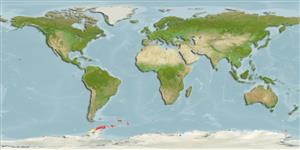| Native range | All suitable habitat | Point map | Year 2100 |

|
| This map was computer-generated and has not yet been reviewed. |
| Amblyraja georgiana AquaMaps Data sources: GBIF OBIS |
Human uses
Fisheries: subsistence fisheries
Phylogenetic diversity index
(Ref. 82805)
PD50 = 0.5010 many relatives (e.g. carps) 0.5 - 2.0 few relatives (e.g. lungfishes)
Trophic Level
(Ref. 69278)
4.2 ±0.3 se; Based on size and trophs of closest relatives
Resilience
(Ref. 69278)
Low, minimum population doubling time 4.5 - 14 years (Assuming tm>5)